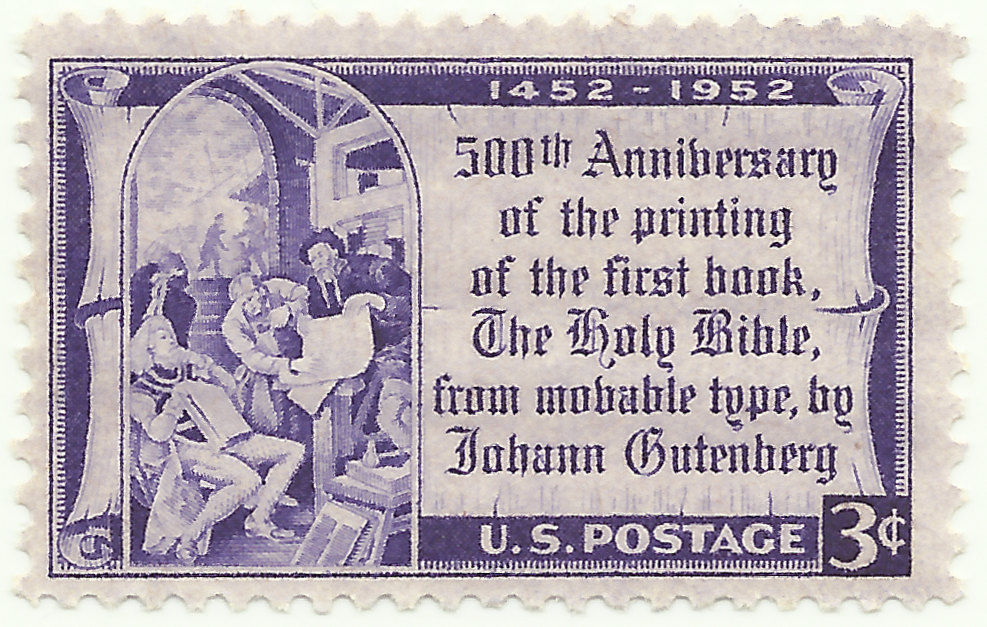Gutenberg's Contribution
Before Gutenberg, books were either copied out by hand on scrolls and paper, and even a small book could take months to complete, or printed from hand-carved wooden blocks, each block printing a whole page, a part of a page or even individual letters. But the wood work was extremely time-consuming and the carved letters or blocks were very fragile and the susceptibility of wood to ink gave such blocks a limited lifespan. Moreover, the hand-carved letters were different. Gutenberg is generally credited with the invention of practical movable type. He made metal moulds, by the use of dies, into which he could pour hot liquid metal, in order to produce separate letters as the same shape as those written by hand. These letters were similar, more readable, and more durable than wooden blocks. Such letters could be arranged and rearranged many times as the printer wished to create different pages from the same letters. Gutenberg also introduced the use of printing press to press the type against paper. For this he used a hand press used in his times by wine industry. Ink was rolled over the raised surfaces of the hand-set letters held within a wooden frame, and the frame was then pressed against the paper. The press enabled sharp impressions on both sides of a sheet of paper and many repetitions. After a page was printed, the type could be reused for printing other pages. Gutenberg introduced his invention around 1450. The Gutenberg Bible
No one knows exactly how many copies of the Bible were printed, but the best guess is that around 180-145 on paper and a few more on the more luxurious and expensive vellum. A contemporary account by a visitor to Mainz indicates that the book was nearly ready in October 1454 and available for sale by March 1455. Gutenberg's Bible edition is the Vulgate - the Latin version of the Bible prepared mainly by Saint Jerome at the end of the 4th century A.D. and used as the official version of the Roman catholic Church. More about the Gutenberg Bible: Gutenberg Bible - WikipediaThe Gutenberg Bible at the Ransom Center View the British Library's Digital Versions of the Gutenberg Bible Historic ControversyPresenting his findings in a mock trial of Gutenberg at the recent Festival of Science in Genoa, Bruno Fabbiani, an expert in printing who teaches at Turin Polytechnic, said the 15th-century German printer used stamps rather than the movable type he is said to have invented between 1452 and 1455. So, Johannes Gutenberg may be wrongly credited with the production of the first western book printed in movable type, according to the Italian researcher. More about this: http://www.freerepublic.com... According to BBC’s site, Renaissance Secrets: What Did Gutenberg Invent? a system of printing from movable metal type was developed in Korea using Chinese characters an entire generation before Gutenberg is thought to have invented it. However, there’s no evidence that this was brought to Western Europe. Even if Gutenberg did learn this from Korea, this is what the BBC states as defining an invention: Invention requires putting together disparate elements in a novel way, making a cohesive, coherent process that can then be carried on by many different people. It was Gutenberg’s combination of the printing press, type, paper and ink that made the invention a success. To sum up: It is safe to assume that Gutenberg is the one who perfected the printing invention to such a degree that it evolved from a non practical process to an extremely practical one. The best evidence for this is the fact that over the next 500 hundred years, from Gutenberg times, many improvement were made in the mechanics of printing but the fundamental process remained essentially the same. More about this controversy: Who Invented the Movable Type? The Invention of Movable Print in China - computersmiths.com The Gutenberg Years: 1640, Celebration and Controversy Johann Gutenberg - Catholic Encyclopedia Gutenberg: Man, Machine, McLuhan, and Mythology - Kim Yates, University of Toronto Build Your Own Movable Type Printing Press
To follow in the steps of Gutenberg you’ll need three components:
Following are a few links that will help you in this effort: Johannes Gutenberg - The Whyville Times Gutenberg´s Invention - Gutenberg Homepage Wine Press Plans - Michael Kakulas Warning: As a rule: this experiment should be performed under the supervision of teachers or adults familiar with safety procedures since presses and carving tools can be quite dangerous. Books |
| Home | Fair Projects | Experiments |
| Scientists & Inventors | Science Jokes | Warning! |





webmaster@julianTrubin.com


